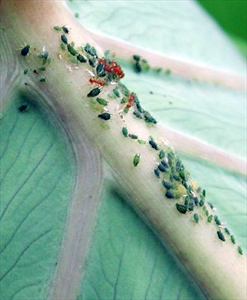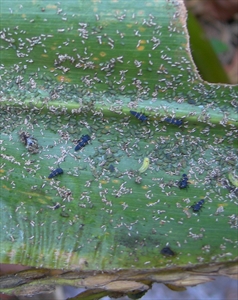Melon or cotton aphid. There are many aphids attacking a wide range of crops; Aphis gossypii, described here, is common in Pacific island countries.
Pacific Pests, Pathogens, Weeds & Pesticides - Online edition
Pacific Pests, Pathogens, Weeds & Pesticides
Melon aphid (038)
Aphis gossypii
Asia, Africa, North, South and Central America, the Caribbean, Europe, Oceania. Aphis gossypii is recorded from Australia, American Samoa, Cook Islands, Fiji, French Polynesia, Guam, Kiribati, Marshall Islands, Federated States of Micronesia, New Caledonia, New Zealand, Niue, Northern Mariana Islands, Papua New Guinea, Samoa, Solomon Islands, Tokelau, Tonga, Tuvalu, Vanuatu, and Wallis & Futuna.
Aphids occur on many crops, ornamentals and weeds; they are common on cucurbits (cucumber, melon, watermelon) and taro. They are also found on banana, bean, capsicum, chilli, citrus and eggplant.
Males are rare or not produced in tropical countries. Eggs are not laid. Females give birth to living young without mating. The young are adult in 4-7 days, after moulting four times. They then produce four to six young a day, up to 50 each. Because of this method of reproduction, populations grow rapidly, with many generations in a year.
Spread occurs by the winged forms of the aphid, and also long distance in winds. Spread also occurs associated with the international movement of plants and plant parts for food and propagation.
Aphids cause direct and indirect damage:
- Direct damage: The damage is caused when aphids feed. Aphids have fine, needle-like mouthparts and they use them to suck sap from plants. When aphids occur in large numbers, young leaves become curled, wrinkled, cup-shaped and smaller than normal (Photo 2). Leaves may wilt, dry up and die early. When populations are high, plants, especially seedlings, become stunted.
- Indirect damage:
- Sooty moulds grow on 'honeydew' - a sweet, sticky liquid produced by aphids as they feed - leaves go black and plant growth is poor (see Fact Sheet no. 51).
- Aphids spread viruses on their mouthparts, such as the viruses of cucurbits -Cucumber mosaic virus, Papaya ringspot virus (watermelon strain) and Zucchini yellow mosaic virus; taro - Dasheen mosaic virus; and beans -Bean common mosaic virus.
Look for groups of round, green (some may be light green, others dark green, almost black) insects on the underside of young leaves, on shoots and buds (Photo 1). They are about 1 mm long, with long antennae about the length of the body, and two tubes at the rear called 'cornicles'. Sometimes, winged forms occur, up to 2 mm long with prominent veins (Photo 3). It is difficult to see the detail of the body with the naked eye. Look for ants, they are often present, tending the aphids for their honeydew.
NATURAL ENEMIES
Aphid predators and parasites usually keep populations low. The most common are ladybird beetles (adults and larvae) (Photos 4,5&6), syrphid fly larvae (Photo 7), lacewing larvae, and tiny parasitic wasps that lay their eggs in the adult aphids. The wasp larvae develop in the aphids eating the inside parts and turning the aphids into empty shells, called 'mummies' (Photo 8). Two important parasitoids are Lysiphlebus testaceipes and Aphidius colemani. Both exist as a number of different strains, so it is important to match the strain with the aphid strain and the environmental conditions.
Note, ants tend aphids for their honeydew. By doing so, they protect them from the activities of parasites and predators. To manage aphids, it is important to remove the ants, so that biological control can operate.
CULTURAL CONTROL
Before planting:
- Do not plant down-wind from crops with aphids. Some aphids have wings, but they are not strong fliers, and are more likely to be blown in the wind onto new crops.
During growth:
- Remove weeds from within and also outside the crop, but note that there are several hundred hosts of Aphis gossypii worldwide.
- Inspect crops often and regularly; destroy leaves heavily infested with aphids by hand (or if necessary use insecticides - see below).
- Mulch the crop. With some mulches, aphids find it more difficult to distinguish the crop plants from bare ground.
After harvest:
- Collect, burn or bury the remains of crops after harvest.
CHEMICAL CONTROL
If ants are present, find the nest, and if not too close to the plant with aphids, destroy the nest with boiling water. Without ants, predators and parasites may bring about natural control.
- If necessary to use an insecticide, use white oil (made from vegetable oils), soap solution, or horticultural oil (made from petroleum) (see Fact Sheet no. 56).
- White oil:
- 3 tablespoons (1/3 cup) cooking oil in 4 litres water
- ½ teaspoon pure hand soap, not detergent
- Shake well and use.
- Soap:
- Use soap (pure hand soap, not detergent):
- 5 tablespoons of soap in 4 litres water.
- White oil:
- Commercial horticultural oil can also be used. White oil, soap and horticultural oil sprays work by blocking the breathing holes of insects causing suffocation and death. Spray the undersides of leaves; the oils must contact the insects. A second application of soap or oils may be necessary after 3-4 weeks. Home-made preparations are ideal for small numbers of plants, but commercial products are probably the only practical solution when crop areas are large.
Alternatively, use:
- Plant-derived products, such as neem, derris, pyrethrum and chilli (with the addition of soap). (see Fact Sheet no. 56.)
- Synthetic pyrethroids are likely to be effective, but will also kill natural enemies. However, they can be used to kill ants, which often tend aphids for their honeydew, and protect them from effective control by predators and parasitoids.
--------------------
Note, derris (Derris species) contains rotenone, an insecticide, often used as a fish poison; it should be used with caution. The commercial derris insecticide is made from Derris elliptica.
____________________
When using a pesticide, (even a biopesticide) always wear protective clothing and follow the instructions on the product label, such as dosage, timing of application, and pre-harvest interval. Recommendations will vary with the crop and system of cultivation. Expert advice on the most appropriate pesticide to use should always be sought from local agricultural authorities.
AUTHORS Helen Tsatsia & Grahame Jackson
Information from Waterhouse DE (1998) Aphis gossypii. Biological control of Insects: Southeast Asian Prospects. ACIAR Monograph no. 51, 548pp. and Choate PM, et al. (2018) Melon aphid or cotton aphid. Featured Creatures. UF/IFAS, University of Florida. (http://entnemdept.ufl.edu/creatures/veg/aphid/melon_aphid.htm); and Melon aphid Aphis gossypii (2016) Agriculture and Natural Resources, University of California. (http://ipm.ucanr.edu/PMG/r116300711.html); Melon or cotton aphid Aphis gossypii (2013) Center for Urban Ecology and Sustainability, University of Minnesota. (http://cues.cfans.umn.edu/old/inter/inmine/Aphidsmc.html). Photo 6 Graham Teakle. Canberra, Australia. Photo 8 Caroline Smith. University of Tasmania, Australia.
Produced with support from the Australian Centre for International Agricultural Research under project PC/2010/090: Strengthening integrated crop management research in the Pacific Islands in support of sustainable intensification of high-value crop production, implemented by the University of Queensland and the Secretariat for the Pacific Community.











